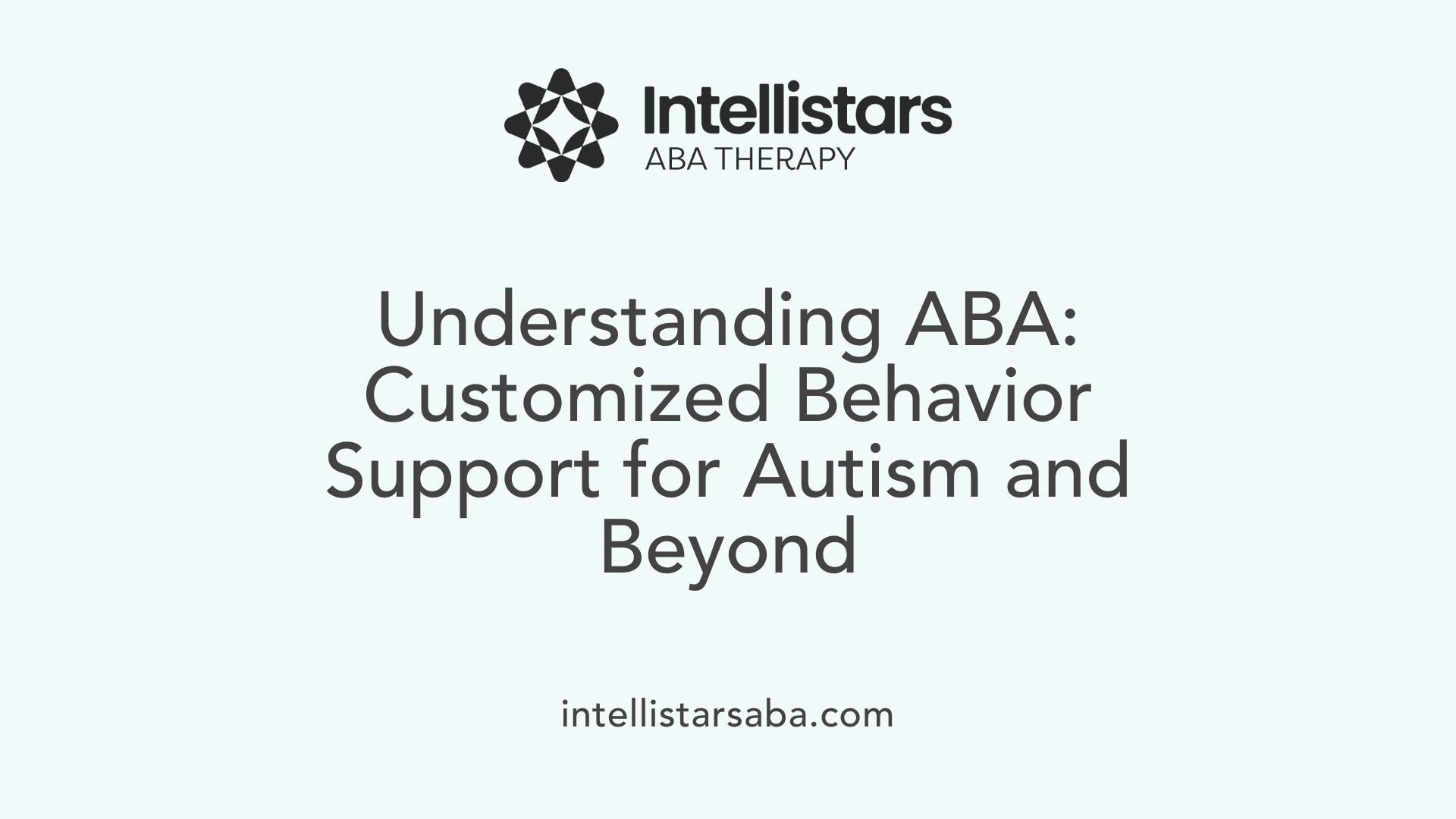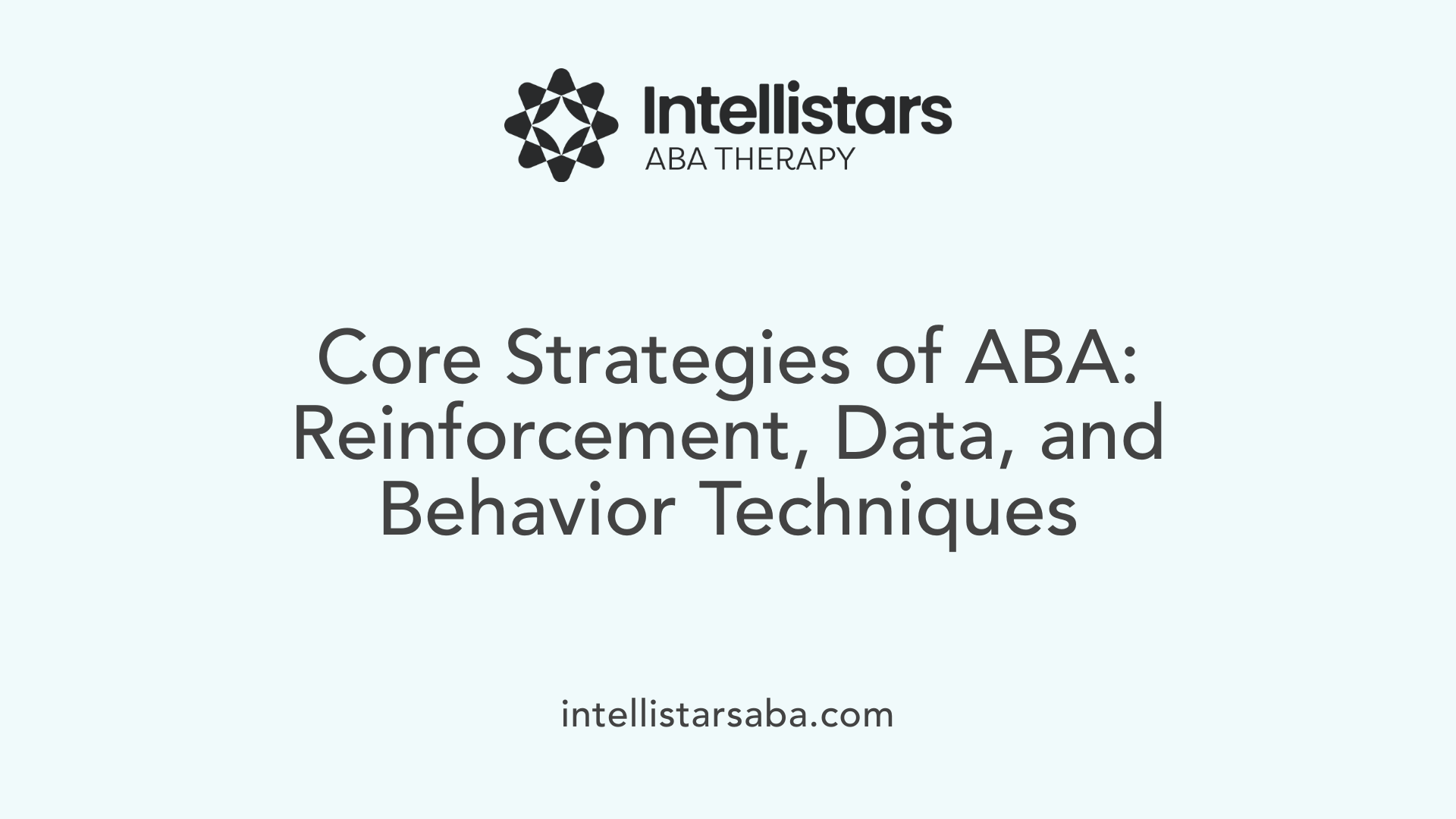Understanding the Basics of ABA Therapy
Applied Behavior Analysis (ABA) is an evidence-based therapy rooted in the science of learning and behavior. Developed in the 1960s by psychologists like Dr. Ivar Lovaas, ABA has evolved into one of the most effective interventions for individuals with autism spectrum disorder (ASD) and other developmental conditions. This comprehensive approach aims to help individuals acquire new skills while reducing challenging behaviors, thereby promoting independence and improving quality of life.
Defining ABA Therapy

What is ABA therapy?
Applied Behavior Analysis (ABA) is a science-based method used to understand and change behavior. It is particularly well-known for helping individuals with autism spectrum disorder (ASD) improve social skills, communication, and academic abilities while reducing harmful behaviors. ABA involves creating personalized programs guided by trained behavior analysts, who assess the individual's needs and develop strategies to promote positive change.
Therapists often use techniques such as positive reinforcement, prompting, and functional behavior assessments to shape behavior effectively. ABA can be delivered in a variety of settings, including at home, in schools, or in community environments, making it flexible to suit each person’s unique circumstances. Overall, ABA aims to support individuals in gaining independence and participating fully in society by encouraging helpful behaviors and decreasing behaviors that interfere with learning or safety.
Core principles of ABA
The foundation of ABA is built on understanding how behavior is influenced by the environment and learning processes. Its main strategies include:
- Positive Reinforcement: Rewarding desired behaviors to encourage their recurrence.
- Analysis of Antecedents and Consequences: Examining what happens before (antecedents) and after (consequences) a behavior to understand and modify it.
- Data Collection and Analysis: Monitoring behavior through detailed data to track progress and adjust interventions.
ABA techniques encompass a range of approaches, such as discrete trial training, natural environment teaching, prompting and fading, behavior chaining, and modeling. These methods are used to teach new skills, improve social interactions, and reduce problem behaviors like temper tantrums or aggression.
Goals of ABA therapy
ABA’s primary aim is to promote meaningful and lasting changes that support an individual's development. Its goals include:
- Increasing engagement in helpful and socially relevant behaviors.
- Teaching essential life skills, including communication, self-care, and social skills.
- Reducing harmful or disruptive behaviors.
- Facilitating skill generalization across different settings and situations.
The therapy also seeks to foster independence, improve quality of life, and enable successful participation in daily activities. Personalized treatment plans are created based on thorough assessments, with continuous monitoring to ensure progress. By focusing on strengths and individual interests, ABA strives to empower individuals to lead more independent, fulfilling lives.
| Aspect | Description | Additional Details |
|---|---|---|
| What is ABA? | A scientific approach to understanding and changing behavior | Used especially for autism, utilizing reinforcement and assessment techniques |
| Core strategies | Positive reinforcement, environmental analysis, data-driven adjustments | Methods include DTT, NET, prompting, and chaining |
| Goals | Skill-building, behavior reduction, independence | Customized to individual needs, emphasizing functional and meaningful skills |
Core Principles and Methodologies

What techniques and methodologies are used in ABA therapy?
Applied Behavior Analysis (ABA) employs a wide array of evidence-based techniques to facilitate behavior change and skill development. Among the most prevalent methodologies is Discrete Trial Training (DTT), which involves structured, repetitive teaching of specific skills through clear instructions and immediate reinforcement. Natural Environment Teaching (NET) emphasizes learning in more natural, everyday settings, promoting the generalization of skills.
Behavior chaining is another vital technique, where complex behaviors are broken down into manageable steps and taught sequentially. Prompting and fading are used to guide the learner toward correct responses, gradually reducing assistance over time to foster independence.
Reinforcement strategies are fundamental: positive reinforcement involves rewarding desired behaviors to increase their occurrence, while negative reinforcement entails removing aversive stimuli to promote a response. Visual aids such as modeling, video modeling, and picture exchange systems (PECS) also play crucial roles, especially in teaching communication skills for individuals with autism.
Other important techniques include behavior shaping through extinction procedures, behavior contracts to establish clear expectations, redirection to guide behavior toward appropriate responses, and script fading to promote spontaneous communication. Functional Communication Training (FCT) is used to replace problematic behaviors with effective communication methods.
Overall, ABA practices rely on systematic assessment, individualized plans, and data collection to ensure interventions are tailored to each person's unique needs, fostering meaningful and lasting progress.
What are the fundamental principles within ABA?
At its core, ABA is guided by key principles that inform the assessment and intervention process. Reinforcement, one of the most influential principles, involves delivering consequences that increase the likelihood of a specific behavior happening again. For example, praise or tangible rewards reinforce desirable behaviors.
Punishment, used cautiously, aims to decrease unwanted behaviors by applying aversive stimuli or removing positive stimuli. However, modern ABA emphasizes positive strategies over punitive measures.
Data-driven decision making is essential in ABA. Practitioners collect and analyze data continuously to evaluate the effectiveness of interventions, make adjustments, and ensure progress aligns with individual goals.
These principles support the development of personalized strategies such as behavior chaining, prompting techniques, extinction procedures, and social skills training. They are adaptable across various environments, including home, school, and community settings, to promote positive behaviors and reduce negative or problematic conduct.
What are subspecialties within ABA?
Within the broad field of ABA, there exist several subspecialties that apply behavioral principles to specific populations or settings. Organizational Behavior Management (OBM), for instance, focuses on improving performance and productivity in the workplace by applying ABA techniques.
Behavioral gerontology targets aging populations, addressing issues such as memory loss, fall prevention, and maintaining independence through behavior modification.
Clinical Behavior Analysis concentrates on treating mental health conditions, including anxiety, depression, and addiction, by applying ABA principles to promote healthier behaviors.
Environmental sustainability is another emerging subspecialty, where behavior interventions encourage eco-friendly practices like conserving energy or reducing waste.
Practitioners in these subspecialties undergo specialized training and certification, enabling them to effectively tailor behavioral interventions to the unique challenges of each population and environment.
Implementation Settings and Professional Roles
Where is ABA delivered?
ABA therapy is highly adaptable and can be provided in various environments to best meet individual needs. Commonly, it is delivered at home, where caregivers are actively involved in implementing strategies and reinforcing learned behaviors. Schools often incorporate ABA into educational routines to promote academic and social skills alongside classroom activities.
Clinics and treatment centers offer more structured, intensive programs with trained professionals. Community settings like parks, recreational centers, and social venues provide naturalistic environments where skills can be practiced in real-life situations.
This flexibility helps ensure that learning is relevant, functional, and transferable across different parts of a person’s daily life.
Who supervises ABA programs and what qualifications do they need?
ABA programs are overseen by Board Certified Behavior Analysts (BCBAs), who are specially trained professionals with in-depth knowledge of behavior analysis. They are responsible for conducting initial assessments, designing individualized treatment plans, and regularly reviewing progress.
Supporting staff often include Registered Behavior Technicians (RBTs). RBTs deliver direct therapy under supervision and guidance from the BCBA.
To qualify, BCBAs must complete rigorous coursework, accumulate supervised experience, and pass a certification exam. Continuous professional development is necessary to stay updated on best practices and ethical standards.
How can families access ABA services?
Accessing ABA begins with consultation from medical or developmental specialists, who can recommend assessment and intervention options.
Families should verify their insurance coverage since many plans cover medically necessary ABA, especially for children under 21. Once coverage is confirmed, they can research qualified providers — asking about credentials, experience, and approaches.
Initial evaluations help create a personalized treatment plan. Ongoing communication with providers ensures the therapy aligns with the child's evolving needs and progress.
Coordination with educational institutions and insurers may be necessary. Advocating for appropriate services and understanding coverage options are key steps in ensuring successful access.
Below is an overview table summarizing the main aspects of ABA delivery:
| Aspect | Details | Additional Notes |
|---|---|---|
| Delivery Environments | Home, school, clinic, community | Ensures relevance and generalization |
| Supervisor Qualifications | BCBA (supervisor), RBT (support staff) | Certification, ongoing training |
| Steps for Families | Consult providers, verify insurance, select qualified providers, initial assessment | Facilitates tailored intervention |
This structured approach allows for flexible, effective, and individualized implementation of ABA to support those with developmental needs.
Benefits, Effectiveness, and Criticisms
What are the benefits and effectiveness of ABA therapy?
Applied Behavior Analysis (ABA) therapy is a validated, research-based treatment that helps individuals, especially children with autism, develop new skills and reduce challenging behaviors. It is highly customizable, employing techniques like positive reinforcement, prompting, and naturalistic teaching to bolster abilities in communication, social skills, daily living, and academic performance.
Research consistently supports ABA’s effectiveness, especially when started early and conducted intensively—often 25 to 40 hours per week over several years. Such intervention can lead to notable improvements in language, cognitive skills, and social interaction, providing children with greater independence and quality of life.
Programs are tailored through ongoing assessment, ensuring each child's unique needs are addressed. This individualized approach offers measurable progress, making ABA widely regarded as an evidence-based best practice in behavioral therapy.
What themes do critics associate with ABA?
While ABA has proven benefits, it also faces criticism. Historically, some early ABA practices involved aversive techniques, such as punishment, which have since been phased out.
Critics often argue that ABA can be overly repetitive and compliance-focused, sometimes neglecting emotional well-being and personal identity. There are concerns that such therapy might cause masking or suppression of authentic self-expression, leading to trauma or loss of neurodiverse identity.
Autistic self-advocates frequently highlight that traditional ABA aims to make autistic children conform to neurotypical standards, which they see as problematic and disrespectful of individual differences.
Modern ABA practitioners emphasize more naturalistic, play-based methods that respect autonomy, aiming to support meaningful participation while minimizing harm. They advocate for approaches that prioritize the child's preferences and strengths, fostering a more positive and respectful therapeutic environment.
How effective is ABA in improving skills for children with autism?
Numerous studies affirm ABA’s strong track record in enhancing communication, social skills, and adaptive behaviors in children with autism.
Early intervention, involving about 25-40 hours of therapy weekly over several years, has been linked to significant gains in language development, self-care, and academic readiness.
The personalized nature of ABA allows therapists to focus on each child's particular strengths and challenges, adapting goals as progress occurs. Data-driven assessments throughout the therapy enable continuous refinement, ensuring the most effective strategies are employed.
Overall, when delivered intensively and early, ABA can produce lasting, meaningful improvements that help children participate more fully in society and develop skills necessary for independence.
Application to Broader Populations and Future Directions

What are applications of ABA beyond autism?
Applied Behavior Analysis (ABA) has evolved from primarily supporting children with autism spectrum disorder to serving a broad range of populations and settings. Its principles are widely applicable in addressing various behavioral challenges and enhancing skills across different groups.
ABA techniques are used to manage problem behaviors in individuals with developmental disabilities, mental health conditions, and behavioral issues such as addiction and anxiety. For example, ABA strategies can help reduce self-harm or aggressive behaviors and promote positive behaviors in various contexts.
Beyond individual therapy, ABA is employed in organizational behavior management to improve workplace efficiency, improve staff performance, and foster positive workplace environments. It also plays a role in supporting aging populations by promoting independence in daily activities.
Environmental sustainability is another emerging application, where ABA encourages eco-friendly behaviors such as recycling and energy conservation. These diverse applications showcase ABA’s flexibility and relevance across many sectors.
What are current perspectives and ongoing debates about ABA?
While ABA is supported by extensive scientific research demonstrating its effectiveness, it is not without controversy. Critics, especially advocates of neurodiversity, raise concerns about certain traditional practices that involved strict behavioral controls, which some view as overly repetitive or discouraging of individuality.
Modern ABA emphasizes naturalistic and person-centered approaches, such as play-based or functional communication training, which focus on respect and autonomy. These approaches aim to balance developmental gains with the child's comfort and preferences.
There are ongoing efforts to reinforce ethical protocols, including ensuring informed consent and reducing reliance on manipulative techniques. The future of ABA involves broadening research inclusivity, refining therapeutic practices, and integrating stakeholder perspectives, especially from autistic individuals and their families.
What career opportunities exist in ABA?
The expanding field of ABA offers a variety of career paths for professionals at different levels of certification and experience. Entry-level roles include Registered Behavior Technicians (RBTs), who work directly with clients under supervision, implementing behavioral programs.
More advanced positions include Behavior Analyst Assistants (BCaBAs) and Board Certified Behavior Analysts (BCBAs), responsible for designing and overseeing intervention plans. For those with doctoral qualifications, opportunities extend to strategic leadership, research, and policy development (e.g., BCBA-D roles).
Career options are available across healthcare, educational settings, private practices, community programs, organizations specializing in organizational behavior management, and even correctional facilities. The demand for ABA practitioners is increasing nationwide and globally.
Ongoing professional development and certification are essential for career advancement. Specialization areas such as behavioral gerontology, organizational behavior management, or trauma-informed care can further diversify career options.
| Population Served | Typical Roles | Settings | Areas of Specialization |
|---|---|---|---|
| Children with autism | RBT, BCBA | Homes, clinics, schools | Social skills, communication, daily living |
| Adults with developmental disabilities | BCBA, BCaBA | Community centers, residential facilities | Vocational training, aging support |
| Mental health patients | Behavioral therapists | Hospitals, outpatient clinics | Anxiety, mood disorders |
| Organizational environments | Organizational behavior management specialists | Workplaces | Productivity, safety, team dynamics |
| Aging populations | Geriatric behavior specialists | Nursing homes, community programs | Independence, cognitive support |
This diverse array of opportunities reflects a growing recognition of ABA's versatility and the increasing need for qualified practitioners across multiple fields.
The Transformative Impact of ABA
Applied Behavior Analysis stands as a cornerstone in behavioral intervention, especially for children with autism. Its scientific foundation, systematic techniques, and focus on individualized goals have demonstrated measurable benefits and broad applicability. As the field continues to evolve, with greater emphasis on ethical practice and stakeholder involvement, ABA remains a vital, adaptable tool for fostering positive change across diverse populations. Whether as a therapy, a research discipline, or a career pathway, ABA’s principles continue to empower individuals and improve lives, shaping a future where learning and growth are accessible to all.
References
- Applied Behavior Analysis (ABA)
- Applied Behavior Analysis (ABA)
- The Controversy Around ABA
- What Is Applied Behavior Analysis - Exploring ABA ...
- What Is ABA Therapy & How it Works
- Applied Behavior Analysis (ABA) for Children With Autism
- Applied Behavior Analysis (ABA)
- ABA Therapy Goals: 25 Practical Examples & Timelines
- Applied Behavior Analysis (ABA)
- What is Applied Behavior Analysis?






